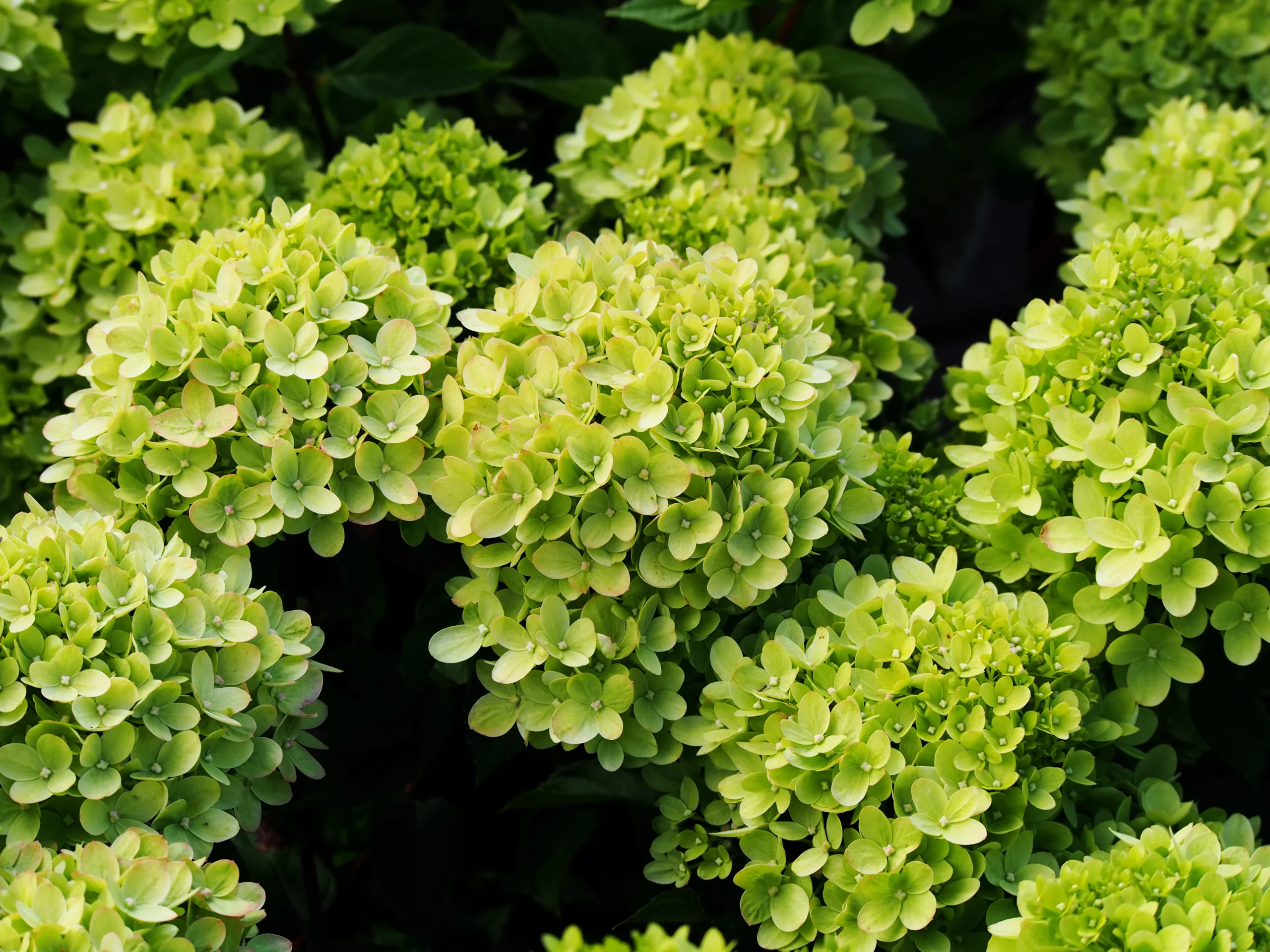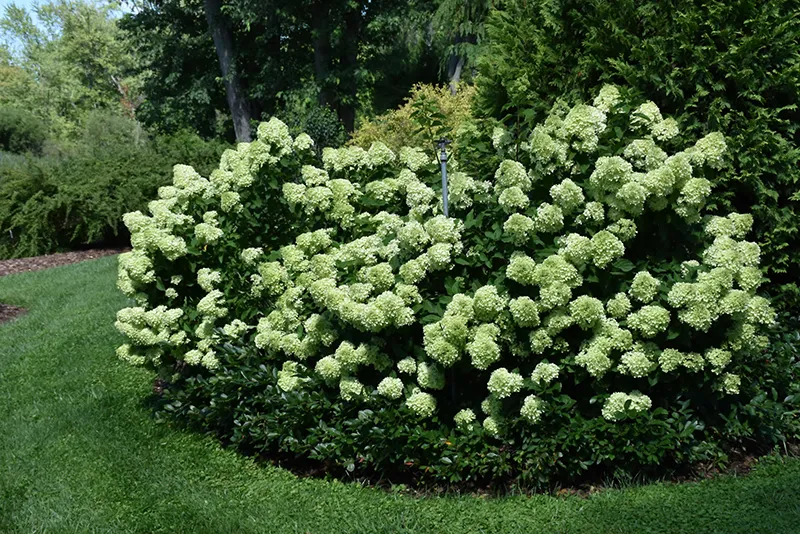Family: Hydrangea
Type: Shrub

Little Lime Hydrangea (Hydrangea paniculata ‘Jane’) is a dwarf version of the popular ‘Limelight’ hydrangea, showcasing similar eye-catching green flowers that turn pink and burgundy in fall. This compact shrub fits beautifully into smaller gardens or landscapes, reaching just 3 to 5 feet in height and width. Its manageable size does not detract from its showy blooms, which light up the garden from summer through fall.
Thriving in full sun to partial shade, Little Lime Hydrangea is adaptable to a variety of soil conditions, though it prefers moist, well-drained soils. Its hardiness and ease of care make it an excellent choice for gardeners of all levels. The shrub’s resistance to pests and diseases further enhances its appeal as a low-maintenance garden feature.
The versatility of Little Lime Hydrangea allows it to be used in numerous landscape applications, from foundation plantings to mixed borders. Its stunning flowers, which start green before transitioning to pink and burgundy, provide a lengthy season of interest. This hydrangea variety also attracts pollinators, adding an ecological benefit to its ornamental value.
Hardiness Zone: 3b-9b
Pet Friendly: Yes
Moisture Preference: Average to moist
Sun Needs: Full sun to shade
Growth Rate: Medium
Average Height (feet): 4
Average Spread (feet): 4
Average Life Span (years): 40
Form: Upright spreading
Flower Color: Green
Secondary Flower Color: Cream
Bloom Season: From mid summer to late fall
Foliage Color: Green
Foliage Shape: Pointy
Bark Color: Gray
Bark Texture: Smooth
Incorporating Little Lime Hydrangea into your landscape design can bring a fresh burst of color and texture to your outdoor space. Planting it in groups creates a dramatic effect, with the shrubs’ lush green flowers making a striking visual statement. These hydrangeas are perfect for creating a low hedge or defining garden boundaries with style and grace.
This hydrangea pairs beautifully with perennials and other shrubs, offering a varied palette of colors and forms. Combining Little Lime with purple coneflowers, black-eyed Susans, or Russian sage can enhance the visual appeal of your garden, providing contrast and diversity. The changing colors of its blooms through the seasons also offer opportunities to design a dynamic, evolving landscape.
For those with limited ground space, Little Lime Hydrangea thrives in containers, bringing its spectacular blooms to patios, decks, or balconies. Container planting allows for flexibility in garden design, making it possible to enjoy this beautiful shrub’s seasonal transformations even in urban settings. Its compact size and robust blooms make Little Lime an ideal choice for container gardening.

Little Lime Hydrangea fits perfectly into the cottage garden aesthetic, with its informal growth habit and profuse blooms complementing the style's abundance and variety. Its flowers add a touch of whimsy and romance to the garden.
In formal gardens, Little Lime Hydrangea can be used to create symmetrical designs or as a focal point in geometric layouts. Its structured form and consistent blooming pattern lend themselves well to more orderly garden designs.
For modern landscapes, Little Lime Hydrangea offers a pop of color and a soft contrast to hard lines and minimalist aesthetics. Its ability to adapt to container planting also suits the flexible nature of contemporary garden spaces.
Use Little Lime Hydrangea to brighten up shaded areas in the garden. Its ability to flower profusely even in partial shade makes it an invaluable asset for bringing color to darker spots.
Design a sensory garden with Little Lime as a key element. The changing colors of its blooms from summer through fall, along with its attractive foliage, engage the senses and create a dynamic garden experience.
Incorporate Little Lime Hydrangea into a wildlife-friendly garden. Its flowers attract pollinators, while its dense foliage can provide shelter for birds and small wildlife, enhancing the garden’s biodiversity.
Select our pre-made garden layouts to create a landscape that’s uniquely yours. Simple, smart, and customizable!
In spring, Little Lime Hydrangea begins to leaf out, providing a fresh, vibrant green backdrop as the garden awakens from winter.
Summer is when Little Lime truly shines, with its lush green blooms creating a cooling effect in the garden. As the season progresses, the flowers start their gradual shift to pink.
By fall, Little Lime's flowers transform into rich shades of pink and burgundy, offering a warm, autumnal palette that stands out against the cooling temperatures.
In winter, Little Lime Hydrangea's spent blooms and sturdy stems add structure and interest to the garden landscape, even as other plants retreat for the season.
Sedum rupestre 'Angelina'
Monarda didyma
Hakonechloa macra 'All Gold'
Little Lime Hydrangea thrives in locations that offer full sun to partial shade. Choose a spot in your garden that gets at least 4 hours of sunlight daily for optimal growth and blooming.
This hydrangea variety prefers a mix of sun and shade throughout the day. Morning sun with afternoon shade is ideal, especially in hotter climates, to protect it from intense heat.
Plant in moist, well-drained soil that is rich in organic matter. Little Lime Hydrangea prefers slightly acidic to neutral soil pH levels but is quite adaptable.
Space plants approximately 5 feet apart to allow for growth and air circulation, which helps prevent diseases and ensures each plant can showcase its stunning blooms.
The best time to plant Little Lime Hydrangea is in the spring or fall when the weather is cooler, allowing the plant to establish itself without the stress of extreme temperatures.
Dig a hole as deep as the root ball and twice as wide. Place the hydrangea in the hole, ensuring it’s at the same level it was in the container, fill in with soil, water well, and mulch around the base.
Water regularly to keep the soil moist, especially during dry spells. Little Lime Hydrangea benefits from deep watering that reaches the roots, encouraging healthy growth.
Fertilize in early spring with a slow-release fertilizer formulated for flowering shrubs. Avoid over-fertilizing, which can lead to more foliage at the expense of blooms.
Prune in late winter or early spring before new growth begins. Cut back the previous year’s stems to encourage robust new growth and abundant flowers.
Apply a layer of mulch to retain moisture and control weeds. This is also the time to prune and fertilize to prepare the plant for the growing season.
Continue to water regularly, especially during hot weeks, to keep the soil consistently moist. Monitor for pests and diseases, treating as necessary.
Reduce watering as the plant begins to go dormant. Clean up any fallen leaves to keep the area around the plant tidy and disease-free.
Little Lime Hydrangea requires minimal care in winter. Ensure it is well-mulched to protect the roots in colder zones.
Hydrangea paniculata 'Limelight'
Hydrangea quercifolia 'Gatsby Star'
Hydrangea paniculata DVPPinky
Unlike some hydrangea varieties, Little Lime’s bloom color is not affected by soil pH. Its flowers transition from green to pink regardless of the soil’s acidity or alkalinity.
Yes, Little Lime Hydrangea can be successfully grown in containers. Choose a large container with drainage holes and monitor watering more closely, as container plants tend to dry out faster.
Little Lime Hydrangea typically reaches its full size of 3 to 5 feet tall and wide within 2-4 years, depending on growing conditions and care.
Sign up below to get exclusive deals, discounts, and new plant collections—delivered straight to your inbox! Plus, stay inspired with the latest gardening tips, landscaping trends, and DIY garden ideas. Start growing with us today!
A big thank you for subscribing to the PBN Design newsletter.
We're thrilled to have you join our community. Get ready for exciting updates, insightful content, and more delivered straight to your inbox.
Stay tuned!
Go backA big thank you for subscribing to the PBN Design newsletter.
We're thrilled to have you join our community. Get ready for exciting updates, insightful content, and more delivered straight to your inbox.
Stay tuned!
Go back